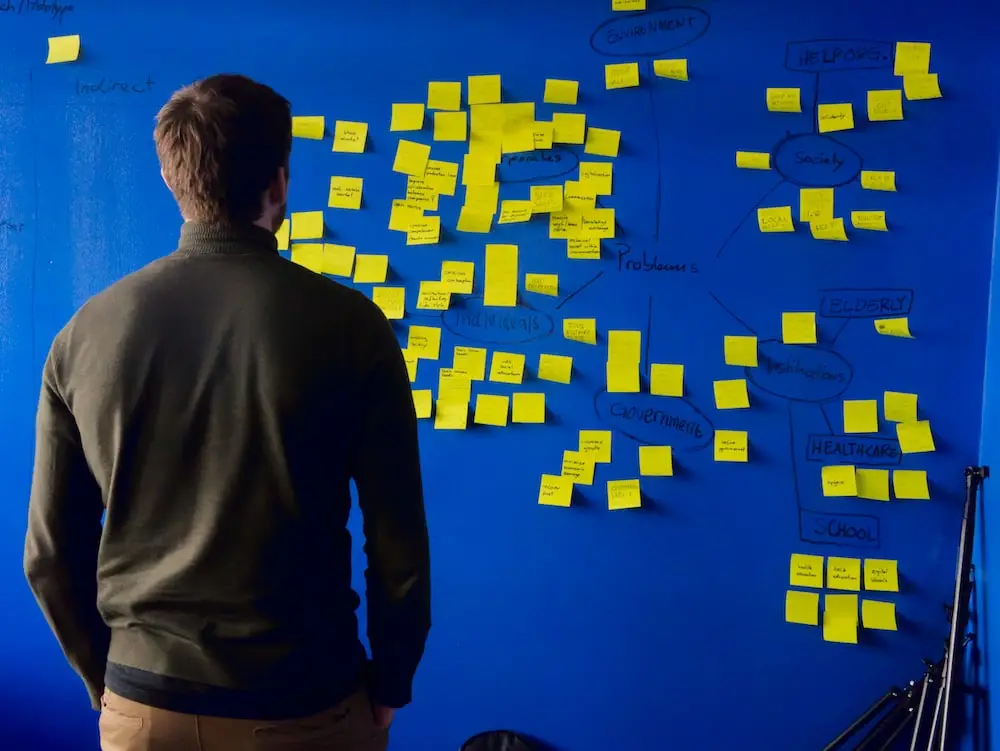The concept of brainstorming
Brainstorming is a creative process that helps generate new ideas. This method can be useful in many fields, from business to education. It is based on a joint discussion of a task or problem by a group of participants who make their suggestions and comments. The moderator acts as a brainstorming leader, encouraging critical thinking and active team participation.
The main goal of brainstorming is to get as many ideas as possible without assessing their feasibility at this stage. Participants should express any ideas, even if they seem silly or impractical. Criticism is prohibited at the first stage, as it can suppress the creative potential of the participants.
The brainstorming method can be used in a variety of areas, from developing new products to solving complex problems. In business, it helps to find innovative solutions and improve team performance. In education, it promotes the development of students' critical thinking and creative skills.
Learn more about brainstorming and its effectiveness. The next section will reveal what exactly brainstorming is and how to conduct it effectively. Wait!
What is brainstorming?

Brainstorming is an idea generation technique that promotes free thinking and stimulates creativity. This method is based on the principle of joint discussion of a task or problem by a group of participants who make their suggestions and comments. The main goal of brainstorming is to get as many ideas as possible without evaluating their feasibility.
| Stages | Description | Example |
| Preparation | Gather the team, determine the topic and duration of the brainstorming session. | Participants: Olena, Tatyana, Olga |
| Idea Generation | Express as many ideas as possible without restriction or criticism. | Ideas: many ideas without evaluating their implementation |
| Analysis and selection | Analyze all presented ideas and choose the best one for implementation. | Selected idea: brainstorming method |
Brainstorming participants can be represented from different fields of activity, as diversity of opinions and views help to find innovative solutions. The moderator typically acts as a brainstorming leader, encouraging active team participation and providing opportunities for critical thinking.
The rules of brainstorming are simple: all ideas are welcome, even if they seem silly. At the first stage, criticism is prohibited, as it can suppress the creative potential of the participants. The main thing is to express as many ideas as possible without limiting your creativity.
The brainstorming method can be used in various areas: in business to find innovative solutions and improve the efficiency of team work, as well as in education to develop students' critical thinking and creative skills.
Now that you know what brainstorming is, let's learn how to conduct it.
How to conduct a brainstorming session?

Conducting a brainstorming session requires certain preparation and compliance with certain rules. The main goal of this method is to get as many ideas as possible without evaluating their feasibility at this stage. Here are some steps to help you brainstorm effectively:
- Clearly formulate the problem or task that needs to be solved. This will help the participants to orient themselves and focus on the main thing.
- Determine the composition of the assault team and the roles they will play. Each participant should have the opportunity to express their ideas and suggestions.
- Provide a relaxed atmosphere and encourage free discussion of ideas. It is important that the participants feel comfortable and freely express their opinions.
- Encourage participants to generate as many ideas as possible without limit. Even unusual and absurd ideas can lead to innovative solutions.
- Do not criticize ideas at this stage, encourage even unusual and absurd views. Criticism can suppress the creative potential of participants, so it is important to create an atmosphere of unconditional expression of ideas.
Basic rules of brainstorming
- Clearly formulate the problem.
- Determine the composition of the assault team and the roles they will play.
- Provide a relaxed atmosphere and encourage free expression of ideas.
- Encourage participants to generate as many ideas as possible without limit.
- Do not criticize ideas at this stage, encourage even unusual and absurd views.
By applying these methods, you will be able to conduct an effective brainstorming session. In the next section, we'll look at common mistakes to avoid when brainstorming. Read on!
Frequent mistakes during brainstorming

During brainstorming, various errors can occur that can affect its effectiveness. Here are some common mistakes to avoid:
- Insufficient team participation: If not all participants actively participate in brainstorming, valuable ideas and perspectives may be missed. It is important to create an atmosphere where everyone feels comfortable expressing their opinions.
- Influence of the moderator: The role of the moderator is to stimulate discussion and gather ideas, not to judge or criticize. The moderator should provide opportunities for free thinking and promote the development of the team's potential.
- Limited time: Not having enough time to brainstorm can lead to haste and poor ideas. It is important to allow enough time for idea generation and discussion.
- Criticism at the first stage: Early criticism of ideas can stifle the creativity of participants and limit the generation of new ideas. Better to save criticism for a later stage, when many ideas have already been expressed.
- The influence of groupthink: Ideas that gain popularity among participants can have advantages over less understood or risky proposals. It is important to give everyone the opportunity to express their opinion without the influence of group opinion.
Benefits of brainstorming
- Increases the number of ideas generated
- Stimulates creative activity and non-standard thinking
- Improves communication and team collaboration
Disadvantages of brainstorming
- There may be an overflow of ideas without the possibility of implementation
- Some participants may fear being criticized
- Requires an experienced moderator for effective conduct
In the next section, we will look at examples of effective brainstorming to inspire you with new ideas. Be with us!
Examples of effective brainstorming

Let's consider some real examples, brainstorming helped different teams to solve important problems.
- The software development team used brainstorming to create new features in the program that helped improve its performance. They turned their attention to methods of optimizing and simplifying the interface, resulting in ideas that made things much easier for users.
- The participants of the business conference held a brainstorming session to find new ideas for the development of their companies. They discussed the possibilities of introducing new technologies, improving marketing strategies and attracting new customers. This allowed them to find non-standard approaches to business development and take a step forward in the competitive game.
- Teachers came together to brainstorm ideas that helped them create engaging lessons and learning methods for their students. They exchanged ideas on the use of new technologies in the educational process, the creation of interactive materials and game formats, which helped to engage students in active learning.
- A group of students brainstormed to find new ways to solve complex math problems. They used methods and techniques that had not been used before, and this allowed them to find non-obvious ways to solve problems.
- The organization's marketing department used brainstorming to create an effective advertising campaign. They discussed ideas about using social media, targeted advertising and creative approaches to attract the attention of the audience. This allowed them to create a successful advertising strategy that produced the desired results.
These examples show how useful brainstorming can be. By bringing out the creative potential of the team and involving diverse ideas, unexpected results can be achieved.
Using brainstorming in different areas

Brainstorming can be used in a variety of fields, including business, education, science, and the arts. This method of generating ideas is an effective tool for finding new solutions and stimulating the creative thinking of the team. Let's take a closer look at each of these areas.
In business, brainstorming can help find new ideas for improving business processes, developing new products or services. The team can discuss opportunities to optimize work processes, promote in the market and attract new customers. Brainstorming helps attract creative ideas and helps avoid stagnation in business strategy.
In the field of education, brainstorming can stimulate students' creative thinking and engage them in active learning. Teachers can hold group discussions where students will discuss new ideas, solve problems and share their thoughts. This contributes to the development of critical thinking and the perception of knowledge from different perspectives.
In science, brainstorming is an effective tool for generating new scientific ideas and solving scientific problems. Scientists can discuss the possibilities of new research, try to look at the problem from different angles and express their hypotheses. Brainstorming stimulates collective thinking and helps to find non-obvious ways to solve scientific problems.
In art, brainstorming can be used to creatively search for new artistic ideas and concepts. Artists can discuss different approaches to creating artwork, experiment with new techniques and materials, which will help them expand their horizons and express themselves through their work.
Conclusion

Brainstorming is a powerful tool for generating ideas that can be used in various fields. With its help, you can find creative solutions to many problems. This method allows you to attract a variety of opinions and views, which contributes to the emergence of non-obvious ideas and new approaches to solving problems.
Brainstorming allows teams to combine their efforts and work together to find innovative solutions. It is worth remembering the rules of brainstorming, such as the generation of as many ideas as possible without restrictions, the absence of criticism at the first stage and the active participation of all participants.
The application of brainstorming can be useful in many fields, including business, education, science, and the arts. It helps to find new ideas, solve complex problems and stimulates the creative potential of participants.
So, use the brainstorming method to jointly search for ideas and find new ways of development. Remember that there are no limits to creativity and innovation. Let's make the world a better place together through brainstorming!
Questions - Answers
What is brainstorming?
Brainstorming is an idea generation technique that stimulates creative and free thinking. Invented by Alex Osborne, it allows groups of people to come together, share their thoughts and suggestions to solve a problem or find new ideas. When brainstorming, it is important to follow the rules, such as generating as many ideas as possible without limitations, no criticism at the first stage, and active participation of all participants. This method can be applied in many fields, including business, education and science. Using brainstorming, teams can find non-standard solutions and expand their capabilities.
How to conduct an effective brainstorming session?
Effective brainstorming requires adherence to certain rules and participants who are willing to share their ideas. It is important to create an environment that promotes creativity and ease. Before the start of the session, you need to clearly formulate the problem, inform the participants beforehand about the time and duration of the brainstorming session. The main rule is to generate as many ideas as possible without restrictions, even unusual and absurd ones. Any critical attitude at the first stage is prohibited. A wide range of ideas will contribute to finding the best solutions.




